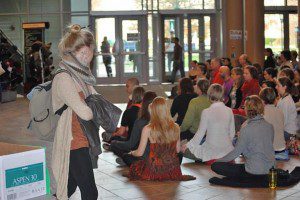 Today I continue the series on obstacles to practice with a focus on self-sabotage that may keep us off the cushion. The other day, I talked about agendas, expectations, and strivng that may arise during practice--in a sense what comes to us unbidden. Self-sabatoge can be pernicious and comes in both gross and subtle forms.
Today I continue the series on obstacles to practice with a focus on self-sabotage that may keep us off the cushion. The other day, I talked about agendas, expectations, and strivng that may arise during practice--in a sense what comes to us unbidden. Self-sabatoge can be pernicious and comes in both gross and subtle forms.
It seems clear from centuries of philosophy and the more recent findings of neuroscience that what we take to be “me” is not a unity but a multiplicity–a collection of “agents” each with their own agendas, fears, and strengths.These agents compete for control and some of these agents are stronger than others or emerge under particular circumstances like stress.
Some of these agents keep us from practicing. We know that meditation is good for us. We’ve read about the research studies demonstrating its effectiveness and perhaps we’ve even had the first hand experience of the value–the profound value–of practice. Still, it can be a struggle to get on the cushion and once on it can be a struggle to stay on. Why is this so?
For some of us, it is hard for some of us to be in an open state–to relax defenses to be in the world with spontaneity and vulnerability. Practice puts us in that “open” neighborhood. There is a nakedness there–a rawness–where it is hard to hide. This can be disorienting. It may take some time to ease into this vulnerability. It may take some practice to get comfortable. It may take granting ourselves permission, but there may be a lot of resistance to accepting this invitation.
David Whyte tells us about vulnerability in his book, The Three Marriages:
If I spend any time in silence, any time watching the way my mind works, I will find that there is a way in which we withhold the very thing from ourselves that might provide us with the possibility of happiness.What we withhold from ourselves is the willingness to understand our own imperfection. The strategic, intellectual self, looking in from the outside, cannot have the experience of sheer physical vulnerability that the deeper internal self must gain to walk though the door of self-compassion. Just as we must leave our partner with certain struggles that are entirely their own, so we must leave our deeper self alone to suffer through the confrontation with its own flaws and imperfections. By letting ourselves alone in this radical way, we actually demonstrate a freeing form of love for that emerging inner person.
For some of us, there is a further complication. The withholding Whyte refers to is a defense mechanism, learned long ago. This defense protected us early in our childhoods by trying to make the self invisible. Not seen, we may escape abuse or soul-crushing criticism. By internalizing the critical voice, we gain some measure of control. Unfortunately, this leads to self-stridency.
This Strident Self is one of the multiple agents that comprise self. When we are feeling bad about ourselves, the Strident Self has taken over. It truly believes it is protecting us. If we engage in meditation, the Strident Self will be out of its job and it does not want to relinquish that control–after all “you need me” it carps. The Strident Self may foster avoidance of practice through procrastination, restlessness, boredom, impatience, devaluation, and poor time management.
We can thank the Strident Self for the protective service it provided long ago and recognize it is time to move beyond it. We can embrace our imperfections as Whyte suggests rather than damning ourselves for them. We can meditate on the restlessness, impatience, and boredom and see what emerges on the other side. We can be playfully suspicious of our resistance to practice and inquire if the Strident Self is active. If so, “thank you, but no thank you” and get on the cushion!

